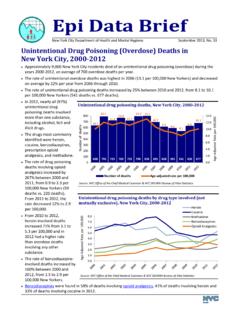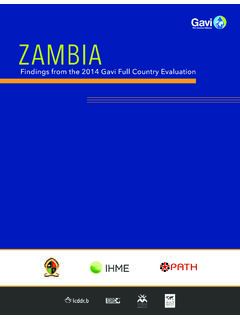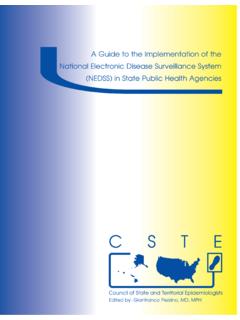Transcription of A Manual: Measuring and Interpreting Malnutrition
1 A Manual: Measuringand InterpretingMalnutrition and MortalityASMRAge-specific mortality rateASMR-U5 Age-specific mortality rate for children under 5 BMIBody Mass IndexCDCC enters for Disease Control and PreventionCMRC rude Mortality Rate/Crude Death RateDHSD emographic and Health SurveysENAE mergency Needs AssessmentEPIWHO Expanded Programme on ImmunizationHIV/AIDSH uman immunodeficiency virus/acquired immune deficiency syndromeHPLCHigh-performance liquid chromatographyICCIDDI nternational Council for Control of Iodine Deficiency DisordersIDDI odine deficiency disordersIMRI nfant mortality rateINACGI nternational Nutritional Anaemia Consultative GroupLBWLow birth weightMICSM ulti-indicator cluster surveysMMRM aternal mortality rateMUACMid-upper arm circumferenceNCHSN ational Center for Health StatisticsNGONon-governmental organizationPPSP robability proportional to sizePSUP rimary sampling unitRBMR esults-based managementSCNU nited
2 Nations Standing Committee on NutritionSRSS ystematic (or simple) random samplingU5 MRUnder-5 mortality rateUIUrinary iodineUNICEFU nited Nations Children s FundVADV itamin A deficiencyVAMV ulnerability Analysis and MappingWFPW orld Food ProgrammeWHOW orld Health OrganizationAcronymsAcknowledgements3 Purpose of the Manual5 Foreword7 Introduction9 Chapter 1 Defining and Measuring malnutrition15 Chapter 2 Defining and Measuring mortality33 Chapter 3 Designing a survey53 Chapter 4 Using and Interpreting survey results 107for decision makingChapter 5 Ethical issues127 Chapter 6 The end point: example of a good survey Paper brief : Food for Paper brief : Micronutrient Fortification Paper brief : Nutrition in Emergencies1792 Anthropometry for height reference in for height reference in percentage of the median 195both boys and for age index in for age reference values for boys for age reference values for girls 2014 Sample data collection forms for a nutrition 203and mortality survey5 Random number table2076 Example of ethical clearance form2097 Resources2178 Glossary of terms2199Q&A sheet227 Table of ContentsMEASURING AND Interpreting Malnutrition AND MORTALITY3As a joint collaboration between the World Food Programme (WFP) and the Centers forDisease Control and Prevention (CDC), we would like to acknowledge the hard work ofthe persons involved in the development of this key technical advisors were Bradley Woodruff and Reinhard Kaiser from the thanks for their technical wisdom, patience and persistence.
3 In addition, warmthanks are given to Roodly Archer and Fiona Galloway of the CDC for their consistentsupport and input into the manual development core WFP team consisted of Rita Bhatia and Leah Richardson. Patrick Webb,Andrew Thorne-Lyman and Soha Moussa were also intimately involved in the develop-ment process - warm thanks for their technical input and illuminating thanks to Kevin Sullivan for his technical review and are many people who have contributed by providing comments on this manu-al and who deserve special mention, for without their help, advice and support, thismanual would not have been possible. In particular, thanks are given to all the staffof Nutrition Service and to the staff involved in the accompanying Pilot AdvancedNutrition AND Interpreting Malnutrition AND MORTALITY5 The Purpose of this ManualWHY THIS manual ? To provide guidance on issues relating to nutrition and mortality surveys.
4 To standardize survey methodology used by WFP staff, consultants and implementingpartners as a means of ensuring quality. To standardize survey data interpretation and reporting. WHO IS IT FOR? WFP staff involved in nutrition-related data collection and/or nutrition interventions. WFP staff involved in nutrition intervention decision-making. WFP consultants and partners involved in nutrition surveys and DOES IT CONTAIN? A chapter on anthropometry and micronutrient deficiencies. A chapter on mortality. Guidance on deciding when secondary data are of sufficient quality for WFP purposes,thereby rendering a new survey unnecessary. A chapter on survey methodology, including an essential guide on selecting appropriatesurvey methods and calculating sample size. Guidance on Interpreting and using survey results along with available complementarymaterials to make informed decisions. Guidance on reviewing survey reports for quality.
5 Example of a good survey in comparison to a less valid SHOULD IT BE USED? As a reference guide. As complementary material for the WFP Advanced Nutrition Training. As a basis for framing questions/discussions with nutrition IT DOES NOT DO! Does not absolve you of carefully thinking about decisions. Does not provide programmatic guidance on what to do with survey results (guidanceon such issues can be found in the WFP Food & Nutrition Handbook). Does not provide guidance on identifying Malnutrition on an individual basis, butfocuses on population-based Malnutrition . Does not provide guidance on screening for either Malnutrition or nutrition surveillance. Measuring AND Interpreting Malnutrition AND MORTALITY7 While nutrition has been central to WFP's mandate for the past 40 years, its importanceto WFP is growing. Already recognized as a key player in nutrition, WFP plays an increa-singly visible role in micronutrient fortification, HIV/AIDS-nutrition programming, scho-ol nutrition and enhanced maternal and child interventions.
6 Following the ExecutiveBoard's endorsement of three nutrition policies in 2004, WFP's Strategic Plan for 2006-2009 reconfirms the organization's commitment to support improved nutrition amongchildren, mothers and other vulnerable people in both crisis and non-crisis settings. However, achieving greater impact, and more clearly documenting results, will be a chal-lenge. The adoption of nutrition indicators in the context of Results-Based Managementrepresents a significant shift in WFP's use of nutrition data - going beyond monitoringand evaluation to the corporate reporting of nutrition and mortality outcomes. Enhancingthe capacity of WFP staff, partners and national counterparts to collect and interpret sur-vey-derived data will be a key to future successes. It is of utmost importance that suchdata are collected using appropriate methods, interpreted meaningfully (in light of com-plementary information on food security, health, markets, etc.)
7 , and presented and usedin transparent, appropriate ways. This manual was prepared to support such capacity-enhancement, providing rigorousyet accessible advice on survey dos and don'ts . It provides step-by-step guidanceintended not only for nutritionists and nutrition focal points, but for all staff involvedwith data management, programme design and reporting. This is not to suggest thatWFP staff collect most nutrition information; such data are collected frequently bypartners. However, even when they do not themselves design and conduct surveys,WFP staff must be conversant with data quality issues to be able to interpret and useinformation appropriately. In other cases, WFP country offices, often with headquar-ters and regional bureaux support, will indeed directly oversee data collection andanalysis. This manual tells you how. The manual (and its associated training modules) is a team product, combining inputfrom many individuals whose contributions are much appreciated.
8 Future editions areenvisaged, with updates occurring according to developments in nutrition science, sur-vey methods and WFP needs. Feedback is therefore always welcome. We hope that theinformation provided will be widely used and lead to further improvements both in pro-gramming and in our ability to report on successful interventions. Patrick Webb and Rita BhatiaNutrition ServiceWFP, RomeJuly 2005 Foreword Measuring AND Interpreting Malnutrition AND MORTALITY9 IntroductionTHE IMPORTANCE OF NUTRITION ANDMORTALITY INFORMATION FOR WFPS ince its first operations in the early 1960s,the World Food Programme (WFP) hasprovided food to beneficiaries with thedual objectives of saving lives in crises andseeking to enhance lives and livelihoods indevelopment settings. Very often this hasrequired explicit attention to nutrition. Forexample, in emergencies Malnutrition isan important determinant of mortality;food interventions therefore play a key rolein saving lives through their impact on thenutrition and health of affected popula-tions.
9 That is, WFP emergency interven-tions seek to prevent the deterioration, orpromote recovery, of nutritional status ofcrisis-affected people. Outside of emergen-cies, WFP also seeks to improve the nutri-tion of vulnerable subpopulations at criti-cal times in their lives (particularly pre-gnant and lactating women, preschoolchildren, and certain adolescents). In both contexts, operational success( , positive impacts on nutrition)depends on effective use of nutrition data- information that helps define the pro-blem, design appropriate responses, docu-ment change and allow for reporting oneffectiveness. Since 2004, the use of dataon nutrition (and now mortality) has takenon a much higher significance. This can betraced to five important developments:First, in 2004, WFP's Executive Boardendorsed three new nutrition policy papers(see Annexes ). These policies requi-re WFP to more systematically analysenutrition problems and define the mostappropriate responses based on up-to-dateknowledge and best practice.
10 To determinethe nature and scale of problems to beaddressed by WFP requires greater inve-stment in the collection of nutrition informa-tion. As noted in the Executive Board deci-sion above, this means that WFP has toenhance staff capacity in nutritional asses-sment and data collection and needs to be done in terms of staff trai-ning, technical guidance, analytical supportand interaction with field partners engagedin nutrition and other humanitarian work. Second, in 2004, the Executive Boardendorsed WFP's adoption of Results-Based WFP will mainstream nutrition in its programmes, advocacy and partnerships in orderto (i) tackle Malnutrition directly, responding to and/or preventing Malnutrition whenfood can make a difference, and (ii) enhance national and household capacities torecognize and respond to nutritional challenges. WFP will expand its efforts to achie-ve and document positive nutritional outcomes.
















